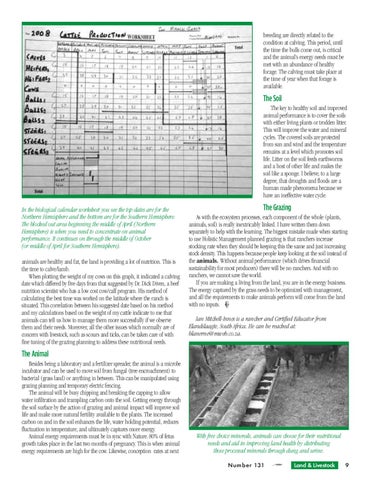breeding are directly related to the condition at calving. This period, until the time the bulls come out, is critical and the animal’s energy needs must be met with an abundance of healthy forage. The calving must take place at the time of year when that forage is available.
The Soil The key to healthy soil and improved animal performance is to cover the soils with either living plants or trodden litter. This will improve the water and mineral cycles. The covered soils are protected from sun and wind and the temperature remains at a level which promotes soil life. Litter on the soil feeds earthworms and a host of other life and makes the soil like a sponge. I believe, to a large degree, that droughts and floods are a human made phenomena because we have an ineffective water cycle. In the biological calendar worksheet you see the top dates are for the Northern Hemisphere and the bottom are for the Southern Hemisphere. The blocked out area beginning the middle of April (Northern Hemisphere) is when you need to concentrate on animal performance. It continues on through the middle of October (or middle of April for Southern Hemisphere). animals are healthy and fat, the land is providing a lot of nutrition. This is the time to calve/lamb. When plotting the weight of my cows on this graph, it indicated a calving date which differed by five days from that suggested by Dr. Dick Diven, a beef nutrition scientist who has a low cost cow/calf program. His method of calculating the best time was worked on the latitude where the ranch is situated. This correlation between his suggested date based on his method and my calculations based on the weight of my cattle indicate to me that animals can tell us how to manage them more successfully if we observe them and their needs. Moreover, all the other issues which normally are of concern with livestock, such as scours and ticks, can be taken care of with fine tuning of the grazing planning to address these nutritional needs.
The Grazing As with the ecosystem processes, each component of the whole (plants, animals, soil) is really inextricably linked. I have written them down separately to help with the learning. The biggest mistake made when starting to use Holistic Management planned grazing is that ranchers increase stocking rate when they should be keeping this the same and just increasing stock density. This happens because people keep looking at the soil instead of the animals. Without animal performance (which drives financial sustainability for most producers) there will be no ranchers. And with no ranchers, we cannot save the world. If you are making a living from the land, you are in the energy business. The energy captured by the grass needs to be optimized with management, and all the requirements to make animals perform will come from the land with no inputs. Ian Mitchell-Innes is a rancher and Certified Educator from Elandslaagte, South Africa. He can be reached at: blanerne@mweb.co.za.
The Animal Besides being a laboratory and a fertilizer spreader, the animal is a microbe incubator and can be used to move soil from fungal (tree encroachment) to bacterial (grass land) or anything in between. This can be manipulated using grazing planning and temporary electric fencing. The animal will be busy chipping and breaking the capping to allow water infiltration and trampling carbon onto the soil. Getting energy through the soil surface by the action of grazing and animal impact will improve soil life and make more natural fertility available to the plants. The increased carbon on and in the soil enhances the life, water holding potential, reduces fluctuation in temperature, and ultimately captures more energy. Animal energy requirements must be in sync with Nature. 80% of fetus growth takes place in the last two months of pregnancy. This is when animal energy requirements are high for the cow. Likewise, conception rates at next
With free choice minerals, animals can choose for their nutritional needs and aid in improving land health by distributing those processed minerals through dung and urine. Number 131
Land & Livestock
9
